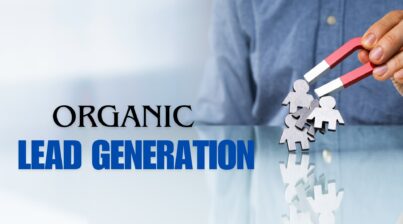In the world of B2B lead generation, it’s tricky. It’s a game of lengthy sales cycles, multiple decision-makers, and long-lasting deals. However, companies find new ways to outpace others. With creative marketing, they can enhance both lead growth and conversion—even in challenging situations. Let’s look at four cases which serve as success stories of B2B lead generation. They show some significant gains. They made use of online marketing, employed CRM tools, and made communication personal. It’s proof: well-planned approaches can pack a big punch.

Case Study #1: Leveraging Digital Marketing to Boost B2B Lead Generation by 150%
Overview
A commercial cleaning and janitorial services franchise faced significant challenges in its marketing efforts, primarily due to a limited digital presence. With no comprehensive digital marketing strategy, the company relied on traditional marketing methods that did not need to yield results.
Strategy
The franchise tackled a problem by setting up a sturdy online advertising plan, starting with a thorough revamp of their website. Once the base was set, they combined paid search (PPC) and search engine optimization (SEO) tactics to boost their web presence. Consistently checking and refining was key to this digital revamp. The plan covered numerous digital marketing avenues, mainly focusing on attracting users via paid search ads and natural search results. Making the website better was also a top priority to ensure that new visitors turned into leads via form sign-ups and calls.
Results
The outcomes of this comprehensive digital marketing initiative were impressive:
3.37% conversion rate across all digital channels.
150% increase in lead generation from 2010 to 2011.
1,500% ROI on SEO efforts in 2011.
200% ROI on PPC campaigns in 2011.
This significant improvement demonstrates the value of integrating digital marketing strategies for lead generation, mainly supported by ongoing optimization and analysis.
Case Study #2: Increasing B2B Lead Generation by 75% Through Marketing Automation and CRM Integration
Overview
A technology asset management service provider encountered inefficiencies in its lead generation processes due to disconnected marketing automation and CRM systems. This lack of integration created operational silos, hindering the flow of information and preventing effective lead nurturing and scoring.
Strategy
The firm tackled some pressing matters by examining its tech tools. They boldly decided to swap out their current sales and marketing software for something more cohesive. This change enhanced the talks between the marketing and sales squads, improving the rating and nurturing of prospects. The company began using a solid method for rating potential customers and expanding its contact list with these updated systems. Leads not immediately secured by the sales team got cultured through programmed procedures, keeping them keen until it was time to close the deal. Plus, having integrated systems strengthened the bond between the sales and marketing teams, boosting total work output.
Results
The technological overhaul led to substantial gains in B2B lead generation:
75% increase in lead generation within the first year.
This case highlights the critical role that marketing automation and CRM systems play in driving B2B lead generation success, particularly when these systems are integrated to work cohesively.
Case Study #3: Achieving 300% ROI Through Targeted Event Marketing
Overview
While digital and automated marketing tactics have become integral to modern B2B strategies, the value of personal interaction remains undeniable. A provider of original equipment manufacturer (OEM) products for the printing industry capitalized on this by integrating event marketing into its B2B lead generation efforts, demonstrating that a blend of traditional and digital methods can yield extraordinary results.
Strategy
The firm ran a variety marketing campaign using direct mail, emails, calls, and events to get the word out and grab new leads. All this was geared around a big industry trade show. The firm used a focused strategy to connect with the right potential customers. The campaign was split up to customize messages and rewards to specific groups, giving high-value rewards like trips to its base or pro sports event tickets. Personal site links (PURLs) were used to see who was engaging and responding, while calls were made to ensure leads were fully checked out before given to the sales team.
Results
The integrated campaign produced outstanding results:
140 qualified leads generated.
300% ROI achieved.
This case exemplifies how blending traditional event marketing with digital tracking and personalization can drive significant returns on investment, even in industries where personal relationships are key.
Case Study #4: Increasing Conversion Rates by 13.4% Through a Combined Email and Teleprospecting Campaign
Overview
In B2B marketing, nurturing relationships with existing contacts can be just as valuable as generating new leads. A drug information provider for health IT companies recognized this and shifted its focus toward converting known contacts into customers, leveraging email marketing and teleprospecting.
Strategy
The campaign kicked off by categorizing the business’s contact list to pinpoint engaged prospects from the past. These selected individuals received an initial e-mail. It set the stage for follow-up calls instead of asking for instant reactions. The first returning phone call occurred promptly after the email delivery. This timely action helped keeps the brand fresh in the minds of the prospects. Four days on, a second email it was landed in their inboxes. The personalized text reminded them of the first email and phone conversation. It ended with yet another round of telephone prospecting to strengthen the initial communication efforts.
Results
The methodical approach delivered exceptional results:
13.4% conversion rate for scheduled meetings.
15.9% of scheduled meetings resulted in new customers.
300% ROI from the B2B lead generation campaign.
This case underscores the effectiveness of personalized outreach and multi-touch marketing in converting engaged prospects into customers.
Conclusion
The following real-life examples showcase the impact of well-planned marketing on high-level outcomes in B2B lead generation. The areas touched include digital change and technology matching, along with tailored communication and event promotion. Each story offers important lessons on methods that bring noteworthy returns on investment. Businesses that adopt these tactics are likely to witness tangible enhancements in their lead generation activities and comprehensive business expansion.




